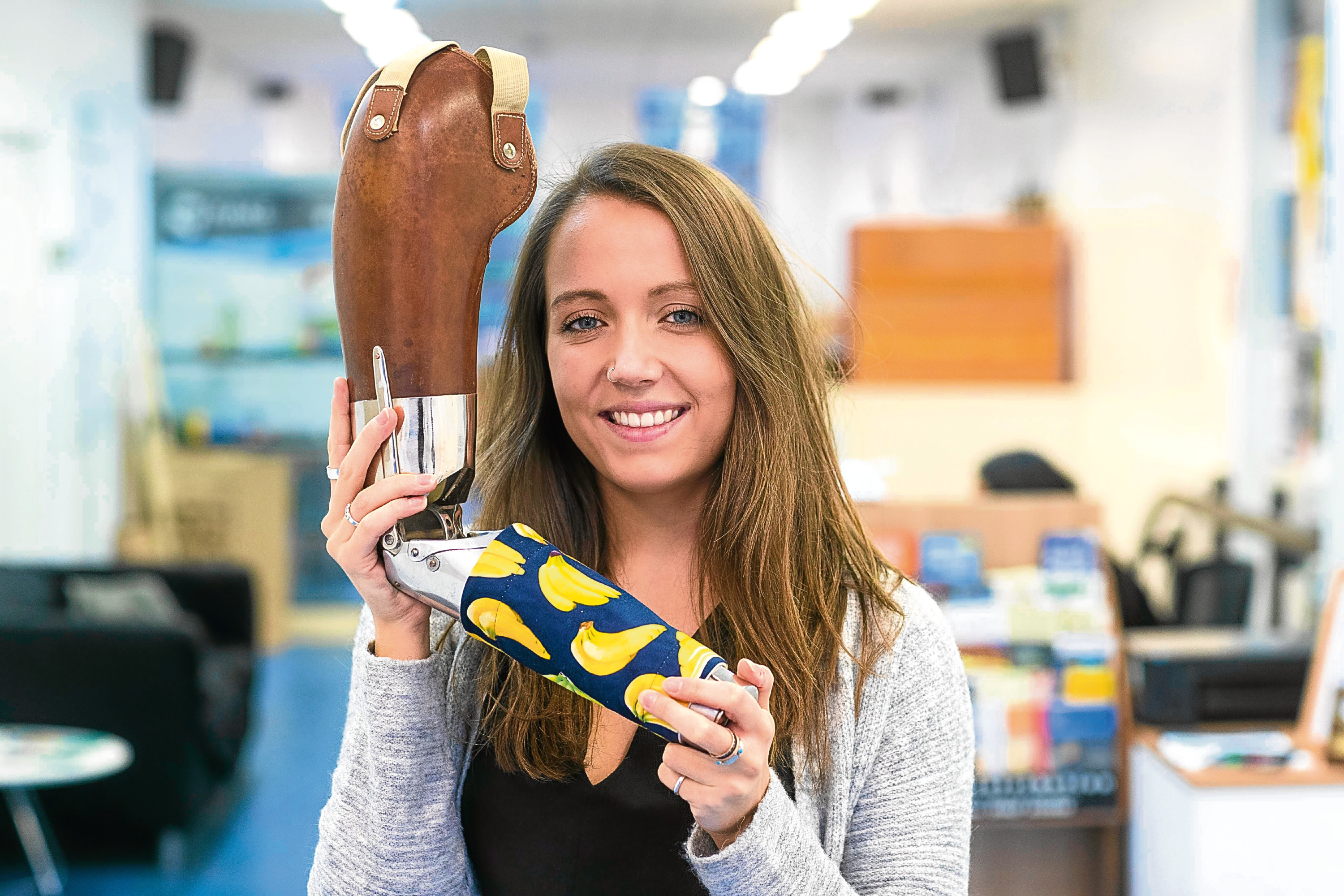
A YOUNG product designer forced to wear a “horrendous, corset-like” back brace as a child is putting a fashionable spin on prosthetics.
Eilidh Earle-Mitchell was diagnosed with the spinal condition scoliosis when she was six.
And while seeing kids her own age fitted with artificial limbs during the years she spent on orthotic hospitals wards was a shock at the time, it’s inspired her to design a product that makes prosthetics look and feel beautiful.
The Aberdeen-based design graduate has created a colourful range of silicone and fabric casings in different designs and materials that can be easily snapped around prosthetics.
She hopes her invention will give wearers a confidence boost.
“You have a different pair of shoes for every outfit. You adapt your outfit to your shoes. Why not do the same with a prosthetic?” said the 21-year-old.
“Prosthetics on the NHS are brilliant but some are a horrible peach colour and don’t look like real skin.
“I wanted to find a way of making prosthetics look better without changing the prosthetic, which is itself a great piece of engineering.”
While Eilidh has never had to wear a prosthetic limb herself, her childhood experience helps her empathise with those who do.
As her scoliosis caused her spine to curve, Eilidh had to wear a restricting orthotic back brace from the age of seven to 11.
“I was in a back brace 23 hours a day. It was like a plastic corset and made me feel very uncomfortable and self-conscious. It was absolute torture,” she said.
“I wore that until I was 11 when it stopped withstanding curves of my spine. I then had to have an operation to fuse my spine with titanium rods and screws.
Watch: Channel 4 series sheds light on Steve, who creates prosthetic limbs for kids for free
“I’m lucky I wasn’t bullied but I couldn’t take part in things like PE and felt like an outsider.
“But I think if I hadn’t had that back brace I wouldn’t be the person I am today.”
Eilidh has been unable to bend her spine ever since the operation but hasn’t let her condition hold her back.
But a further blow came earlier this year – and a decade on from her back surgery – when Eilidh was diagnosed with ankylosing spondylitis, an inflammatory arthritis that affects her spine and joints.
It means her joints can swell up to three times their normal size, sometimes causing debilitating pain.
Despite being bed-ridden for six weeks and missing a chunk of her fourth-year studies, Eilidh persevered and graduated with her honours degree in 3D Design from Gray’s School of Art in June.
“Doing research into prosthetics and creating something I think could help people gave me a real sense of positivity and empowerment,” she said.
“Even if I’m bedbound, I can still help people with my creativity.”
Her positivity has driven her work to accessorise prosthetics beyond being a project for her final year at university.
Now in her current job as Studio Manager for MAKE Aberdeen, a digital fabrication studio specialising in 3D-printing, Eilidh has the perfect space to develop her idea, which she’s called Pro Aesthetic Design.
The idea is that people can customise their prosthetic casings and even upload their own design via a website, that’s still in development.
As well as her a range of fabric cuffs that snap around the plastic body of a prosthetic using a steel spring mechanism, Eilidh hopes to explore other possibilities.
She also wants to look into how creating skin-like casings could potentially help tackle phantom limb pain, where false pain messages to the brain create the illusion that a lost limb is still there.
Mirror therapy, using the reflection of a healthy leg or arm, has been found to ease pain by tricking the brain into believing the amputated limb remains.
Eilidh believes adding a life-like feel to an artificial limb using a casing could create the same psychological effect, and hopes to develop this idea in the future with expert advice.
The product designer’s intention isn’t to hide or mask a prosthetic but make it stand out in positive, striking way.
She said: “I don’t want people to hide what’s happened to them. It’s more about personalising the prosthetics and adapting it to be a beautiful piece of design.
“That could be lace or diamante finishes or more sporty fabrics depending on the occasion. I think the possibilities for this are endless.
“It’s about creating a positive conversation about the prosthetic by making it a talking point in terms of how cool and beautiful it looks.”
Eilidh is looking for prosthetics-users to give her general feedback. Those interested can contact the product designer via proaestheticdesign@gmail.com.

Enjoy the convenience of having The Sunday Post delivered as a digital ePaper straight to your smartphone, tablet or computer.
Subscribe for only £5.49 a month and enjoy all the benefits of the printed paper as a digital replica.
Subscribe